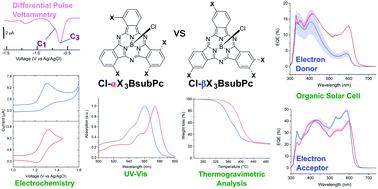当前位置:
X-MOL 学术
›
Mol. Syst. Des. Eng.
›
论文详情
Our official English website, www.x-mol.net, welcomes your
feedback! (Note: you will need to create a separate account there.)
Molecular engineering of α and β peripherally tri-halogenated substituted boron subphthalocyanines as mixed alloys to control physical and electrochemical properties for organic photovoltaic applications
Molecular Systems Design & Engineering ( IF 3.2 ) Pub Date : 2021-2-18 , DOI: 10.1039/d0me00175a Esmeralda Bukuroshi 1, 2, 3, 4 , Siena Wong 1, 2, 3, 4 , Thanmayee Mudigonda 1, 2, 3, 4 , Kyle Nova 1, 2, 3, 4 , Antoine Dumont 2, 3, 4, 5 , Devon Holst 2, 3, 4, 6 , Zheng-Hong Lu 2, 3, 4, 5 , Timothy P. Bender 1, 2, 3, 4, 5
Molecular Systems Design & Engineering ( IF 3.2 ) Pub Date : 2021-2-18 , DOI: 10.1039/d0me00175a Esmeralda Bukuroshi 1, 2, 3, 4 , Siena Wong 1, 2, 3, 4 , Thanmayee Mudigonda 1, 2, 3, 4 , Kyle Nova 1, 2, 3, 4 , Antoine Dumont 2, 3, 4, 5 , Devon Holst 2, 3, 4, 6 , Zheng-Hong Lu 2, 3, 4, 5 , Timothy P. Bender 1, 2, 3, 4, 5
Affiliation

|
The chirality feature of C1 and C3 boron subphthalocyanines (BsubPcs) is an attractive property in material science and supramolecular chemistry. Normally in the field, enantiomeric mixtures are separated through a standard process. The goal of this study was to determine if the mixture of BsubPc enantiomers could form a mixed alloyed composition in the solid state, which is very relevant to their potential application in the organic electronic field. We present the synthesis and physical characteristics of a selection of four chiral BsubPc mixtures. These BsubPcs are specifically trichlorinated and trifluorinated in the periphery, such as Cl-βF3BsubPc, Cl-αF3BsubPc, Cl-βCl3BsubPc and Cl-αCl3BsubPc. The isomeric (C1/C3) ratios of each BsubPc were determined by NMR. Single-crystal XRD of all four BsubPc mixtures showed that the C1 and C3 isomers co-crystallized within their respective lattices forming solid-state mixed alloyed compositions. The structures of Cl-αF3BsubPc and Cl-βF3BsubPc crystallized in the same lattice as Cl-BsubPc, with some expansion of the unit cell volume, while the trichlorinated BsubPcs did not due to the large van der Waals radii of the chlorine atoms. This set of mixed alloyed BsubPcs was also integrated into organic solar cells/photovoltaics (OSCs/OPVs) as both non-fullerene electron acceptors and as electron donors. It was confirmed that these BsubPc isomers/enantiomers are applicable in OPVs as mixed alloyed compositions, with more promising functionality as non-fullerene electron acceptors given their significant contribution to the EQE spectra. Further molecular engineering of these materials will be made to enhance their OPV performance and to explore their bifunctional charge carrier mobility roles.
中文翻译:

α和β外围三卤代取代亚酞菁硼作为混合合金的分子工程,可控制有机光伏应用的物理和电化学性质
C 1和C 3硼亚酞菁硼(BsubPcs)的手性特征在材料科学和超分子化学中是一个吸引人的特性。通常,在本领域中,对映体混合物通过标准方法分离。这项研究的目的是确定BsubPc对映异构体的混合物是否可以形成固态的混合合金成分,这与它们在有机电子领域的潜在应用非常相关。我们介绍了四种手性BsubPc混合物的选择和合成和物理特性。这些BsubPcs具体三氯化和三氟化在外围,如Cl-βF 3 BsubPc,CL-αF 3 BsubPc,CL-βCl 3 BsubPc和Cl-αCL 3BsubPc。通过NMR测定各BsubPc的异构体(C 1 / C 3)比。所有四种BsubPc混合物的单晶XRD结果表明,C 1和C 3异构体在其各自的晶格内共结晶,从而形成固态混合合金成分。CL-αF的结构3 BsubPc和Cl-βF 3BsubPc在与Cl-BsubPc相同的晶格中结晶,但晶胞体积有所扩展,而三氯化BsubPcs并非由于氯原子的范德华半径大。这套混合合金化的BsubPcs还作为非富勒烯电子受体和电子供体,被集成到有机太阳能电池/光伏(OSC / OPV)中。已证实这些BsubPc异构体/对映异构体可作为混合合金组合物应用于OPV,由于它们对EQE光谱的重要贡献,它们作为非富勒烯电子受体具有更广阔的前景。将对这些材料进行进一步的分子工程设计,以增强其OPV性能并探索其双功能电荷载流子迁移性作用。
更新日期:2021-03-19
中文翻译:

α和β外围三卤代取代亚酞菁硼作为混合合金的分子工程,可控制有机光伏应用的物理和电化学性质
C 1和C 3硼亚酞菁硼(BsubPcs)的手性特征在材料科学和超分子化学中是一个吸引人的特性。通常,在本领域中,对映体混合物通过标准方法分离。这项研究的目的是确定BsubPc对映异构体的混合物是否可以形成固态的混合合金成分,这与它们在有机电子领域的潜在应用非常相关。我们介绍了四种手性BsubPc混合物的选择和合成和物理特性。这些BsubPcs具体三氯化和三氟化在外围,如Cl-βF 3 BsubPc,CL-αF 3 BsubPc,CL-βCl 3 BsubPc和Cl-αCL 3BsubPc。通过NMR测定各BsubPc的异构体(C 1 / C 3)比。所有四种BsubPc混合物的单晶XRD结果表明,C 1和C 3异构体在其各自的晶格内共结晶,从而形成固态混合合金成分。CL-αF的结构3 BsubPc和Cl-βF 3BsubPc在与Cl-BsubPc相同的晶格中结晶,但晶胞体积有所扩展,而三氯化BsubPcs并非由于氯原子的范德华半径大。这套混合合金化的BsubPcs还作为非富勒烯电子受体和电子供体,被集成到有机太阳能电池/光伏(OSC / OPV)中。已证实这些BsubPc异构体/对映异构体可作为混合合金组合物应用于OPV,由于它们对EQE光谱的重要贡献,它们作为非富勒烯电子受体具有更广阔的前景。将对这些材料进行进一步的分子工程设计,以增强其OPV性能并探索其双功能电荷载流子迁移性作用。











































 京公网安备 11010802027423号
京公网安备 11010802027423号